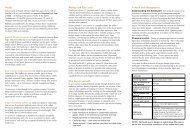Bushland Weeds Manual - Environmental Weeds Action Network
Bushland Weeds Manual - Environmental Weeds Action Network
Bushland Weeds Manual - Environmental Weeds Action Network
You also want an ePaper? Increase the reach of your titles
YUMPU automatically turns print PDFs into web optimized ePapers that Google loves.
Chapter 5 Broadleaf Herbs, Sedges and Succulents<br />
Other annual weeds establish by rapidly dispersing<br />
into recently disturbed sites. Many annual weeds of the<br />
Swan Coastal Plain and Jarrah Forest belong to the<br />
daisy family (Asteraceae), a group with largely wind<br />
dispersed seed. They are able to disperse effectively<br />
into sites of soil disturbance, rapidly growing and<br />
exploiting available resources (McIntyre et al. 1995).<br />
Often the most prolific is the wind dispersed Flat Weed<br />
(Hypochaeris glabra) (Box 5.2).<br />
Box 5.2 Fire and soil disturbance in a<br />
Banksia woodland<br />
The disturbance caused by fire and then the handremoval<br />
of Yellow Soldier (Lachenalia reflexa), an<br />
introduced bulb, in study plots in Shenton <strong>Bushland</strong><br />
encouraged the establishment of weedy annuals.<br />
Fire<br />
The initial increase in cover of annual broadleaf<br />
weeds that occurred over 1998/1999 across all plots<br />
was probably a reflection of conditions following<br />
the October 1997 fire. The gaps created by the fire<br />
and the increased nutrient levels provide ideal<br />
conditions for annual weed establishment.<br />
Soil disturbance<br />
Where Yellow Soldier was removed by hand and<br />
the soil disturbed, the cover of annual weeds<br />
increased to an even greater degree. Flat Weed<br />
(Hypochaeris glabra) was the most prolific. With its<br />
wind dispersed seed and flat rosette of leaves it is<br />
a prime example of a weed able to disperse<br />
effectively and rapidly exploit available resources.<br />
Other broadleaf annual weeds colonising the plots<br />
included Ursinia (Ursinia anthemoides), French<br />
Catchfly (Silene gallica), and Slender Suckling<br />
Clover (Trifolium dubium). Any hand-removal<br />
program aimed at controlling bulbous weeds such<br />
as Yellow Soldier in Banksia woodland is likely to<br />
result in colonisation by annual weeds.<br />
Percentage Cover<br />
45<br />
40<br />
35<br />
30<br />
25<br />
20<br />
15<br />
10<br />
5<br />
0<br />
control<br />
hand removal<br />
herbicide<br />
1998 1999 2000<br />
Year<br />
Figure 1. The cover of weedy annual herbs in plots (2 m x 2 m)<br />
for three years following fire. Bars indicate standard errors.<br />
Keeping out fire<br />
Fire can also facilitate invasion of annual weeds into<br />
bushland. Weed seed builds up in the soil seedbank<br />
between fires. After fire many annual weed species<br />
germinate, exploit available resources and set seed<br />
before native species (Fisher 1998, Perez-Fernandez<br />
et al. 2002). In the two years following fire at Shenton<br />
<strong>Bushland</strong>, the cover of annual weeds at study sites<br />
increased greatly (Box 5.2).<br />
Assisting regeneration of the native plant<br />
community<br />
Management that favours the regeneration of native<br />
plant communities increases competition against<br />
weeds. Annual weeds, probably more than any other<br />
weeds, can be displaced and prevented from<br />
establishing through careful bush regeneration -<br />
encouraging regeneration of the native plant<br />
communities and allowing native plants to fill gaps<br />
(Bradley 1988, Vranjic et al. 2000). This can be a<br />
particularly useful tool when fast-growing native<br />
perennials are present (Box 5.3).<br />
Stimulating the native soil seedbank to germinate by<br />
the use of smoke or smoke-derived products (Dixon<br />
et al. 1995, Roche et al. 1998) is one way to encourage<br />
regeneration of the native plant community. At most<br />
disturbed sites weed management will be labour<br />
intensive and ongoing until a cover of native species is<br />
well established.<br />
Direct seeding with local provenance seed<br />
If there is no native soil seedbank remaining, as in<br />
many degraded sites on the edge of bushland (Fisher<br />
1998), then direct seeding the site is the next option.<br />
Consider the following:<br />
• The great diversity of native flora of south west<br />
Western Australia is recognised internationally.<br />
Less well known is the diversity we cannot see,<br />
hidden diversity in the genetic make up of our flora<br />
(Byrne 2002). In order to protect the integrity of<br />
that genetic diversity, always collect seed locally,<br />
i.e. from bushland adjoining the restoration site.<br />
Collecting seed for restoration work locally is, at<br />
present, the only way to avoid introducing nonlocal<br />
genetic material and non-local forms of plants<br />
to bushland. It also ensures plants established are<br />
adapted to local conditions (Box 5.4).<br />
• Ensure that the species selected occur on the soils<br />
and are from the plant community of the site that is<br />
being restored. Vegetation maps, species lists and<br />
near-by intact bushland are useful reference points.<br />
• Think about species selection. When the aim of the<br />
project is to displace annual weeds along a<br />
disturbed edge, think about selecting easy to<br />
establish, fast-growing species. Remember though,<br />
returning as much of the natural diversity to the<br />
site as possible is the long-term objective.<br />
• Weed control will be ongoing for many years until<br />
a cover of native plants is well established.<br />
57



